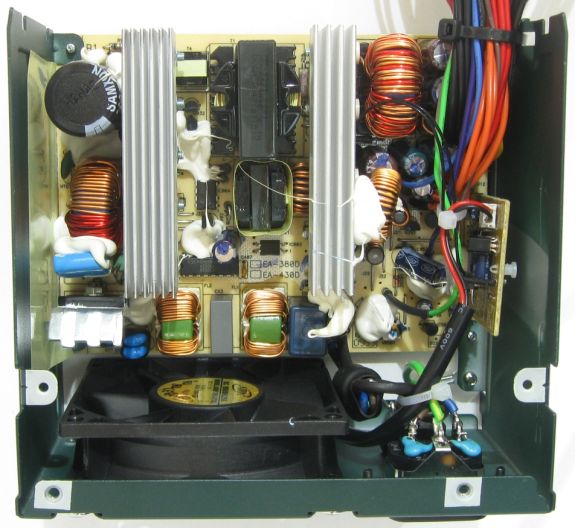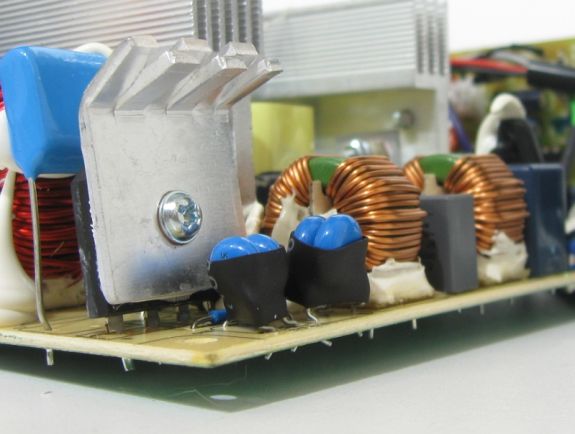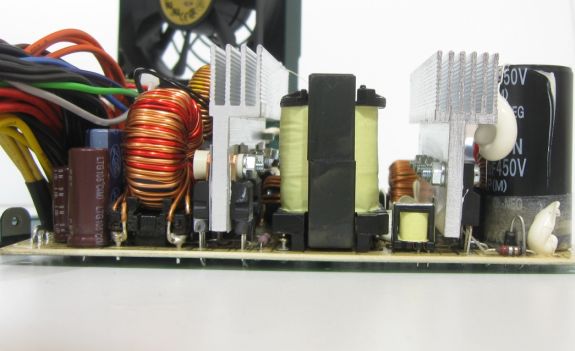Antec EarthWatts EA 380D Green 380W
by Martin Kaffei on October 2, 2010 7:00 PM EST- Posted in
- Cases/Cooling/PSUs
- PSUs
- Green
- Antec
- Earth Watts
- 380W
Internals
After opening the PSU, a well-structured design can be seen with two rather slim heat sinks, which are positioned according to the airflow. Similar to the first EarthWatts models (designed by Seasonic), the heat sinks don’t form a tunnel topology, which means that the airflow isn’t as linear as we have seen elsewhere--i.e. an Arctic Cooling PSU with their thoughtfully positioned air foil. But there is less energy dissipating into heat because of the lower nominal power and higher efficiency and there are large spaces inside where the air is able to circulate. The position of the rectifier bridge with its heatsink and the EMI-filter slightly hinder the airflow.
The IEC-plug is followed by the mains switch, which engages the phase conductor when thrown. Two Y-caps are connected with a protective ground wire, which is securely fixed on the case. Additional glue would be useful to improve mechanical stability. Well-twisted phase and neutral wires are coiled around an additional ferrite core and securely soldered. If wires are not twisted well, the connection could easily break. [Note: The quality in Chinese factories is still fluctuating.]
Two common mode chokes, four Y-caps, and two X-caps follow, with another X-type cap located behind the rectifier bridge; however, a varistor is missing. From this perspective we can see how precisely the chokes are fixed. In the power factor pre-regulator, we find a Samxon capacitor with the model number MXL. The Champion-IC 6800AG regulates the PFC and the main circuit of the PSU. This IC features OCP (Over Current Protection) and short circuit protection and has become popular because of its low-loss controlling.
Since the glue can’t always be positioned accurately, the 12V-choke is stabilised with a socket, which is useful at certain sizes. The costs are higher and the processing is more complicated. This kind of fastening is more likely to be found in high-end models. Sometimes this method is impossible, since the space is limited. The last model with this feature was the Enermax Revolution85+ 850W, where the size of the PFC-choke was the problem. In the OEM sector it is common to fix the components above necessity.
The +12V rail is filtered by Nippon Chemi-Con (KZE) and Ltec (LZG) capacitors, while on the smaller rails a potpourri of Nippon Chemi-Cons, Ltecs, and a single Taicon are used. A metering diode on a heat sink measures the temperature.
The noted build quality continues with a high soldering quality. Most conducting paths are cleanly soldered, but the output cables of the secondary circuit had to be cut so the wires don’t protrude too much under the PCB. Usually the manufacturer should be able to estimate the lengths of the wire when using THT-components. Connections could break if protruding wires are cut off. On the solder points of phase and neutral wires, solder residue can be found because of a very high soldering temperature, but there are no damages visible.














64 Comments
View All Comments
Vesperan - Monday, October 4, 2010 - link
*raises hand*Low end PC, with a HD5750 for graphics. Build a couple of months ago, only needs a small power supply.
That said, if the power supply hadn't have come with the NSK3480 case, I likely would have gotten a bigger power supply.
enterco - Monday, October 4, 2010 - link
Yes, I consider this kind of PSU since the first green series. It has been used in Antec NSK4480 case. I consider this a VERY good choice for corporate PCs.PS: Not every PSU goes under the reader's desktop.
cknobman - Monday, October 4, 2010 - link
Umm I used an Antec 380 Earthwatts in my home server build.Dont knock Anandtech because of your short-sightedness you just make yourself look like a fool!
Great review Anand this power supply is freaking awesome and definitely the best buy you can get for a unit under 400 watts.
I got mine on the egg after rebates for $29.99 too!!!
jjcrandall - Monday, October 4, 2010 - link
I'll raise my hand to this review. I was looking at purchasing this exact model a couple weeks ago for an HTPC.digdugsmug - Wednesday, October 13, 2010 - link
I used one of these for an esx server. Yeah yeah its not exactly a server PSU but its fine in a home environment. I wanted good efficiency since its always on and low cost, this thing delivers both!pattakosn - Saturday, January 29, 2011 - link
use a watt-o-meter on your rig and get back to us with your setup and wattage please...Maybe you will then like to reconsider reading this review...
Wineohe - Saturday, October 2, 2010 - link
Although this might seem small, it is still too big in my opinion to be considered green. If you are claiming to be green, how about something in the 250W range, or smaller! A gamer is probably not going to bother looking at this article anyway because they think they need 1000W, even though they could probably do with much smaller. Come on it's like buying 94 Octane when most of us drive Corollas.khimera2000 - Saturday, October 2, 2010 - link
I think its becaus there trying to target the mid range market as well ;) they mention something about it in the second to last paragraph in the conclusion... then again you can always check the first page of the review to they have a mention of it there to.JGabriel - Monday, October 4, 2010 - link
"A gamer is probably not going to bother looking at this article anyway because they think they need 1000W ..."Most readers and gamers here are computer and physics literate people - not withstanding the ignorance of the second top-level commenter above - who know they only need 400 -700 watts for a high-end SLI/Crossfire gaming machine, and 200 - 300 watts for anything less. Many of us also build HTPCs for the home, and the occasional machine for friends and/or family, or advise them in their own purchases.
You really should readjust your expectations and cliches in accordance with that.
.
strikeback03 - Tuesday, October 5, 2010 - link
Well the series does include smaller models, and this is probably what Antec sent them.